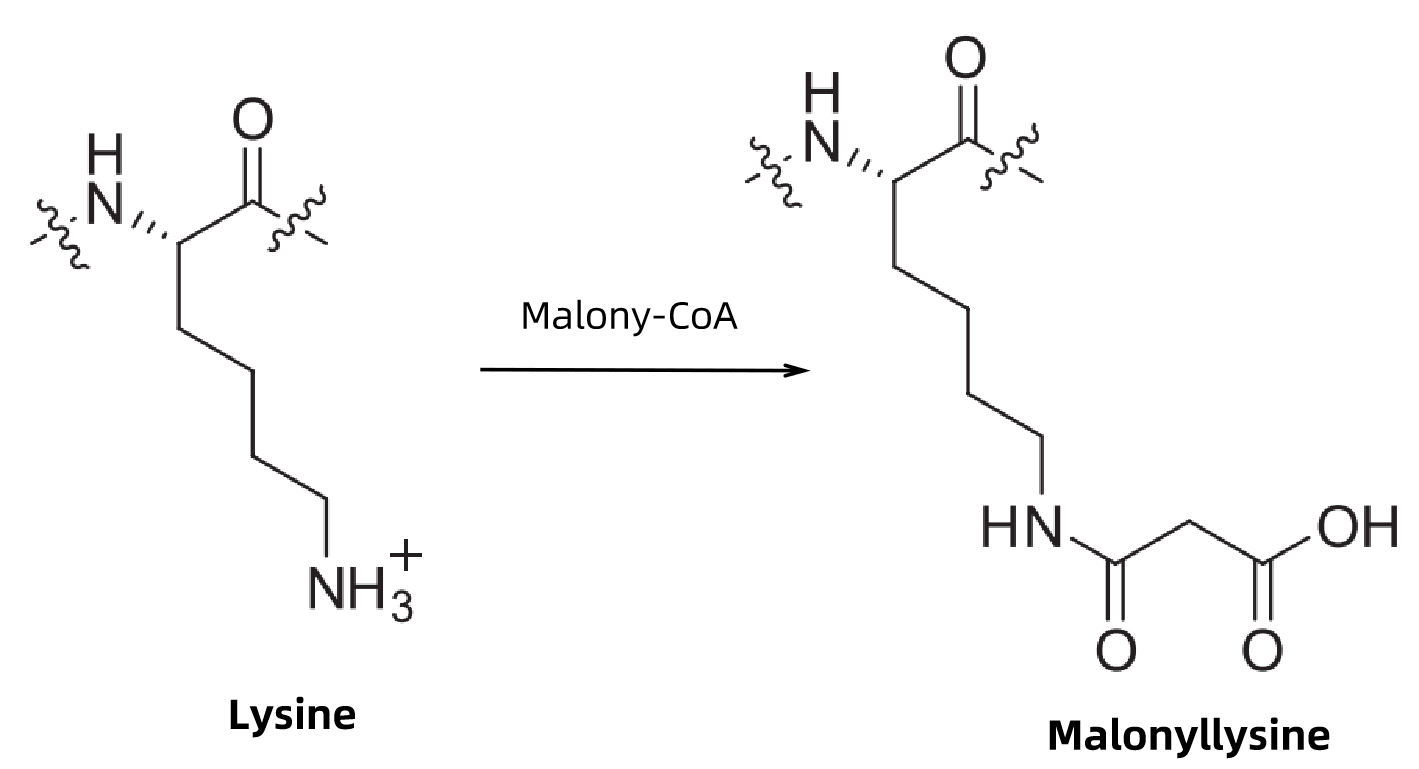Quantitative Malonylation Service
- Regulating tumor cell proliferation, migration, and apoptosis.
- Contributing to neuronal metabolism regulation, particularly in neurodegenerative diseases.
- Modulating photosynthesis and plant stress response mechanisms.
- Playing a key role in inflammatory and immune responses.
Protein malonylation is a post-translational modification (PTM) involving the covalent attachment of malonyl groups (such as malonyl-CoA) to lysine residues on proteins, catalyzed by specific enzymes. Lysine residues typically carry a positive charge, but malonylation converts this to a negative charge, leading to alterations in protein charge distribution, which can affect protein conformation and interactions. This modification is reversible and plays essential roles in various biological processes.

Figure 1. Lysine Malonylation Process
In recent years, research has increasingly focused on protein malonylation, especially in its role in metabolic regulation, where it plays critical roles in energy metabolism and photosynthesis. Malonylation has been found to affect key metabolic pathways such as fatty acid synthesis, mitochondrial respiration, and glycolysis. It is also implicated in plant stress responses, inflammatory reactions, and the pathogenesis of diseases such as type 2 diabetes. Therefore, understanding protein malonylation mechanisms is crucial for elucidating its biological functions.
MtoZ Biolabs offers a high-precision, high-throughput Quantitative Malonylation Service. Utilizing advanced mass spectrometry in combination with specific antibody enrichment techniques, this service provides researchers with a comprehensive platform for studying malonylation's role in biological processes.
Analysis Workflow
The Quantitative Malonylation Service at MtoZ Biolabs is based on high-resolution liquid chromatography-tandem mass spectrometry (LC-MS/MS), combined with specific antibody enrichment. This platform enables precise identification and quantification of malonylated lysine residues on proteins. By employing TMT/iTRAQ labeling technologies alongside label-free methods, we offer high-throughput sample analysis with exceptional sensitivity and quantitative accuracy. Our services encompass sample preparation, malonyl-peptide enrichment, mass spectrometry analysis, and bioinformatics interpretation, providing a thorough understanding of the functional implications of malonylation under various biological conditions.

Service Advantages
1. High Sensitivity
Our advanced mass spectrometry and enrichment techniques enable the accurate detection of even low-abundance malonylation sites.
2. Comprehensive Coverage
Sample analysis using TMT/iTRAQ labeling and Label-Free techniques significantly enhances experimental efficiency and ensures high-quality data.
3. Quantitative Accuracy
Our cutting-edge quantification methods ensure precise and reliable data, even under varying experimental conditions.
4. Extensive Bioinformatics Support
We offer comprehensive bioinformatics analysis to help researchers explore the roles of malonylation in metabolic regulation, epigenetic mechanisms, and other processes.
5. One-Time-Charge
Our pricing is transparent, no hidden fees or additional costs.
Sample Submission Requirements

For more sample details, please consult our technical team.
Applications
Malonylation is implicated in a range of biological processes, and quantitative analysis can provide valuable insights in the following areas:
Our Quantitative Malonylation Service provides high-quality data support, advancing your scientific research and applications. Free project evaluation, welcome to learn more details! Our technical specialists are available to provide a free business assessment.
How to order?







